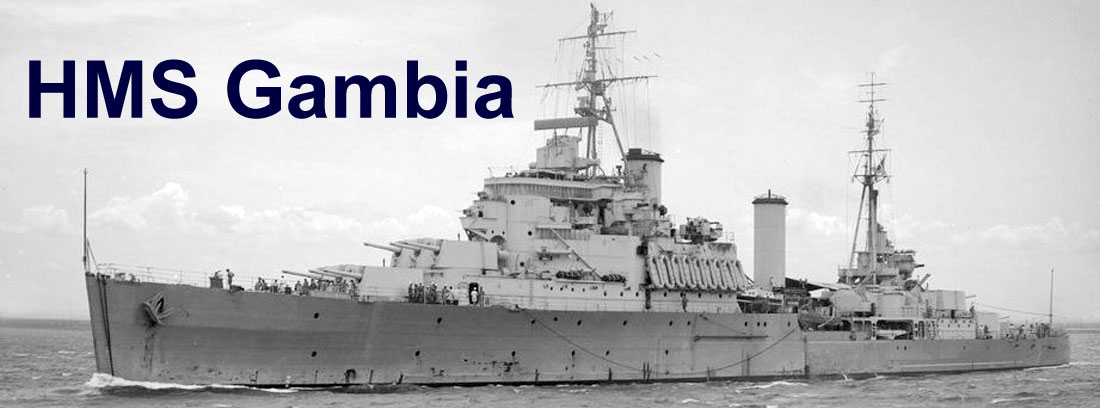
Eddie Gouarne
In April 2020, Anne Irvine, the step-daughter of stoker Eddie Gouarne who served on HMS Gambia for her 1950/52 commission, very kindly sent me a lot of photos and a biography. In the email she first sent she said that "they all looked so happy and young."
The family would often go to the Exservicemans Club in Ayr which has some of Eddie's photos on the wall. Ane says that "We all had lovely weekends down there regularly over the years. He loved his Navy days and often spoke of his travels, he loved Malta in particular, he took mum to visit around 20 years ago and she went pub/club trailling down memory lane with him. Some "scrawny haunts" as she described them! He was on submarines once, hated it and got back onto ships after that. He loved the Royal Navy but did later transfer to Merchant Navy."

Eddie and wife, Ina, in 1959
Anne says that "Eddie was a quiet man, a gentleman, he could dry himself after a shower with a face cloth and kept all his clothes immaculate and organised, shoes polished every night! navy life gave him those skills." About her mum, Ina, Anne says she was 12 years younger than Eddie and that "they were young sweethearts in the late 50s, he went away to navy, mum met my dad, then when she was 50 they got back together and married, a true love story and I was bridesmaid!"
Sadly, Anne's mum, Ina, passed away in 2017 and Eddie passed away in 2002, aged 73.
The Suez Crisis came to a head in 1956 but had been building for several years. After WWII there was a rise in Egyptian nationalism and a strong anti-British feeling in Egypt. In 1951, Nahas Pasha leader of the recently-elected nationalist Wafd party revoked the Anglo-Egyptian Treaty of 1936.
HMS Gambia had sailed from Malta on October 15, 1951 but was held at Port Said with HMS Chequers and HMS Chevron while on way to East Indies to relieve HMS Mauritius. On October 18 the Canal workers went on strike. Gambia spent 5 weeks there before returning to Malta. The Royal Navy took over handling the Canal
Attacks on the British garrison soon followed and in January 1952 the British government authorised an operation to disarm the Egyptian paramilitary police force in Ismailia which was orchestrating the violence. This was successful, but resulted in the deaths of 41 Egyptians and the violence continued. Riots in Cairo of an unprecedented scale followed, culminating in attacks on Saturday 26 January on British property and the expatriate community, thereafter known as Black Saturday.
Anti-British feeling continued to rise and this led to HMS Gambia and other British forces being sent to Suez to keep the canal open in June 1952. On 23 July, 1952 a military coup by the Egyptian nationalist 'Free Officers Movement' led by Muhammad Neguib and future Egyptian President Gamal Abdul Nasser, overthrew King Farouk and established an Egyptian republic.

A newspaper cutting of the time detailing the work of HMS Gambia in October 1951.
The cutting in Eddie Gouarne's photo album, very kindly scanned by Anne and her husband.
The cutting reads:
Navy's Important Contribution to Middle East Defence
The considerable naval contribution to the security of the Middle East was acknowledged by the Prime Minister (Mr. Churchill) when H.M.S. Gambia returned to Malta on completion of a month's period of strenuous duty at Port Said. He asked the First Sea Lord Admiral of the Fleet Lord Fraser) to compliment the ship on her good work.
Upon the Gambia fell the main burden of keeping Port Said open to all shipping during critical period when the Egyptian staffs of vital water services had been intimidated into unemployment. The ship quickly became known as "The Floating Shipping Office."
Seventy of her ship's company became temporary watermen, while the other officers and men of her crew operated services to keep the harbour party at work. Working in six assault craft, two fast motor boats, a pinnace and a cutter, the harbour party moored hundreds of ships of many nations and enabled some seven and a half million tons of international shipping to continue passage through the canal in orderly convoys.
Day and night the sailors hauled great mooring lines to the mooring buoys which bob like giant children's tops off the minaretted waterfront. Spontaneous cheering by British and foreign merchant crews greeted the sailors' work. One mooring craft was lifted out of the water by a foreign merchant ship's propeller which started to turn prematurely. Another was rammed and beached. But both craft were brought back into service within twelve hours by the ship’s engineers.
Apart from the task of maintaining the flow of world traffic through the Suez Canal, there is the job of unloading stores for the Zone. This is the Army's responsibility, but the Navy is doing a number of technical jobs and is providing a harbour patrol at night to prevent pilfering. The patrol craft, armed with rifles and with searchlights in the bows, swoops on suspicious centres and preserves thousands of tons of British property needed within the Zone.
The presence of ships of the Mediterranean Fleet at Port Said, and also in the Bitter Lakes and at the Suez end of the canal, has inspired confidence in the European populations in the area, and this confidence was strengthened on 15th November, when H.M.S. Triumph (Capt. U. H. R. James, C.B.E., R.N.) arrived at Port Said with elements of the 39th Infantry Brigade of the 3rd Infantry Division, her flight deck and hangars crowded to capacity with troops and equipment.

A page from Eddie's photograph album
Anne and her husband very kindly scanned them all and those are presented below...








































































